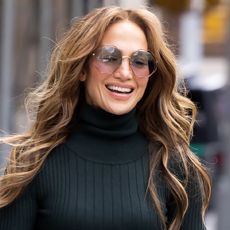Mrs. Harris Goes to Paris Is a Sartorial Feast for the Eyes
The beauty of fashion and costume design is its ability to evoke deep emotion. Seeing a beautiful dress traipsing down the runway or a spectacular pair of shoes on display in a store window can instantly put you in your feels. You know, that heart-fluttering, "can’t stop thinking about it,” " I have to have it” kind of feeling. Not to be hyperbolic, but it’s a powerful thing. In Focus Features’ latest film, Mrs. Harris Goes to Paris, its title character, a widowed cleaning lady, experiences just that when she comes across a breathtaking Dior Haute Couture gown hanging in the wardrobe of the woman whom she works for. Overcome with joy at the mere sight of the mauve beaded floral gown, she scrounges every last penny and sets out on a journey to purchase a custom Dior look of her own.
For a film like Mrs. Harris Goes to Paris, the costuming is essential, if not a character in itself. So director Anthony Fabian called in one of the greats—Jenny Beavan, the costume designer behind Cruella, The Nutcracker and the Four Realms, and Mad Max: Fury Road, to name a few—to help bring its 1950s sartorial story to life. From re-creating a Dior Haute Couture show to sourcing vintage floral-print aprons and dresses worn by the era’s charwomen, no detail was spared by Beavan and her team, making the film a true visual delight for any fashion connoisseur. I had a chance to speak with Beavan to get the story behind the film’s most glamorous looks. From digging into the Dior archives to creating the identities of each character and overcoming quarantine challenges, she breaks it all down below.

Can you start by sharing your process of going into a new project? Where do you begin?
I always begin with the script and the director’s vision, if he has one. Some do, some don’t, and that’s a very particular thing to a director. As I read the script, I make lists for each character and what they may or may not need. At the same time, you are probably looking at research and getting a real feel for the period and type of people. And if it’s a film like Mrs. Harris, which is set in the ’50s, there will be stock in a costume house, so you actually go and start pulling and looking at the real clothes and putting them on a mannequin. That process all happens together while you are waiting for fittings to come. … Until you know whether it’s a tiny actor—it could be Lesley Manville or Anna Chancellor—there is not much point in putting too much out. And that’s how it all starts, whatever the film is. If you don’t have a costume house to go to, you hopefully have a workroom, and you just start making clothes so you have something to try on the actor when they come in.
Mrs. Harris Goes to Paris is set in London and Paris in the 1950s. When creating the mood boards or treatment for the film, what were some of the specific references that helped guide your vision for the costumes?
Partly my own memory because I remember 1957 quite well, and partly, there’s a lot of photographs out there. So I was really looking at mainly photographs rather than newsreel stuff. And the Mrs. Harris and the Vi [types] are very much in London at that time. There were lots of people coming in from Jamaica and the West Indies, so we had a lot of photographs of people and what they were wearing to give us a good sense of it. And then simple things like a bus conductor. You would find lovely pictures of bus conductors beaming off the back of London buses. Generally, it’s not a difficult period. I had family photos I could look at. My father loved taking photographs and developing them, and my mother would put them in an album. So I had a lot of that to draw on as well as what was out there in the world.
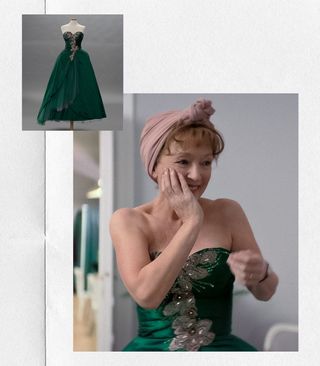
This must be a unique situation because the story is centered around the house of Dior specifically. What was it like working with the brand and getting access to the archives?
Well, that was absolutely wonderful to be given access. They were so helpful. But I had taken the film on in the understanding that I was going to be working alongside Dior, and they would be doing all of the Dior bits, and anything I wanted, they would make. In your dreams! So obviously, we ended up making and re-creating a lot of that [couture] show and had to do it at a standard that Dior would approve. We had to honor Dior. So that access to the archives was fantastic and seeing the way he worked and seeing some of the real dresses—not that there are many, because they didn’t realize the importance of keeping anything in those days. They didn’t realize they would want archives for a museum. They did the show, they did the collection, they sold it, [and] they moved on to the next collection. It wasn’t something they envisioned needing a museum for.
Did you have any other unique challenges?
I went to the archive late in 2019 before COVID, but by the time we came to make [the film], it was full-on COVID, so it was restricted in terms of getting around London and getting fabric. We were cast as essential workers and were allowed to go to Cosprop so we could pull clothes, and they would bring in staff on an as-needed basis. Getting the right fabric was tricky. We could buy a bit, but it wasn’t easy. And then on top of that, fittings were really tricky. They managed to cast about eight actors in Paris three days before they stopped anyone traveling. So those fittings had to be done at a French costume house with a French costume designer I didn’t know, but I got to know and became very grateful for [her]. She would fit the actors. I sent her the photographs, what I thought they should look like. She would fit them in the costume houses and send the photographs back, and at least I knew they would arrive in Budapest where we were filming with something to wear. And sometimes, it was perfect, and sometimes, I would totally redress them. The fittings with Isabelle Huppert we did via Zoom in her sitting room. It was definitely a challenge. But if you’ve got good people in the right places, you can do it.

Ada Harris falls in love with a couture Dior dress, which sets her on a journey to purchase one of her own. How did you go about selecting or designing the dress that starts Ada’s infatuation?
That’s a dress we made, and it had to fulfill several story functions. One was that it had to look good on Lady Dant. Now, they went through a lot of different cast possibilities for Lady Dant, and Anna Chancellor is very tall and a really wonderfully statuesque woman, very beautiful, but not everything would suit her, so we just had to make sure it was a dress that, when she picks it up and holds it against her, it looks absolutely possible that it would look fantastic on her. And I think it does. The floral aspect was also important because of Mrs. Harris’s love of flowers, and that would be something that she would react to in a very positive way. And then it was about what fabric we could get. Luckily, right around that time, Shepherd’s Bush opened up, which has a lot of interesting fabric stores, a lot of them from India. [It’s] beautiful stuff and a really diverse collection. And Sally Turner—who had been staged in England to look after not only the making of the Dior but [also] be someone in England to keep an eye on everything we needed to have sent out to Budapest—she went and found that fabric. I’m not quite sure where she found it, but she knows everybody, so she can get places opened up and has ways and means of finding people. So that’s how that dress came to be. It had to be something that Mrs. Harris would love and that would look great on Anna Chancellor.
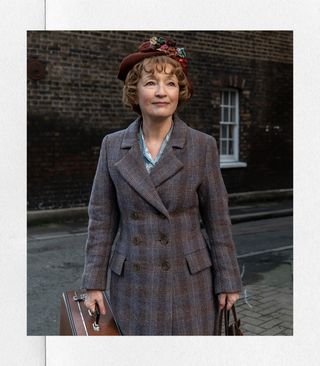
I want to talk about the costume inspiration for some of the individual characters. Let’s start with Mrs. Harris. Her look is a stark contrast to the glamorous world of Dior. Did you look a lot at what charwomen wore during that time?
Well, she’s a cleaner, and she doesn’t have much money, but she has this hope that her Eddie will come home [from the war], so she would keep herself nice. People did then. They looked after their clothes. They didn’t have a lot. I loved doing the double-floral thing, and those are both vintage, the apron and the dress. They are just real. So that first look when she’s holding the dress and she’s all in floral became her signature look, and everything else branched out from there. When she goes to Paris, she borrows [André’s] sister’s clothes. Sandrine we called the sister. We decided to invent a whole character who was this woman who is the sister of André, who worked at Dior and was slightly boring but studious. I mean boring in that his job as an accountant but obviously much more interesting in his existentialist times. It’s always the thing of trying to make sure the story holds true. But really, what’s interesting is if we put Lesley Manville in the clothes top to bottom, she’d look like Sandrine. If we kept Lesley’s shoes and stockings, then she looked like Mrs. Harris dressed up in Sandrine’s clothes, and that was terribly important to me, and I still like that moment.
Her floral hat is another signature. Where did that come from?
The hat is mentioned in the novella, I think. To be honest, what I do with hats, because they are so individual to people… I think we had a wonderful fitting where we had Lesley’s wig so we could actually try different hats, and we had to make two of them. I can’t remember why. Was it something that we had to double? And again, getting stuff to do that was tricky at that time, so I was digging through all the boxes of fake flowers. It was a hat that just worked on Lesley and was the sort of hat you would have as your best and can retrim, like the ladies in Jane Austen who were always trimming their bonnets. With the floral thing, I do it instinctively if that’s what the character likes.

Natasha is the Dior muse and has a little bit of an Audrey Hepburn vibe to her. What was your vision for that character?
You just said it, Audrey Hepburn. Her pedal pushers and the simplicity of the real girl who actually wanted to study philosophy but happened to be really good as a model… Obviously, it’s a brilliant way of making money, so why not do it? But I love that change in her, and that was a really fun thing to do.
What about Vi Butterfield, played by Ellen Thomas? I noticed she favored a lot of bold prints.
[Vi] is lovely. She is one of the many Jamicans that came over to help us because we were very lacking in a lot of service industries in England in the ’50s. I remember my nanny Jackie was from Jamaica and how wonderful she was. I just found glorious dresses. They were all real that she is wearing. They are all vintage. But the coat is wonderful because when we put the coat on her, she had a moment. … Apparently, her mother had a coat exactly like that, and she suddenly was looking at her mother. It was a really lovely and charming memory, so that coat was there to stay. I was thrilled with that.
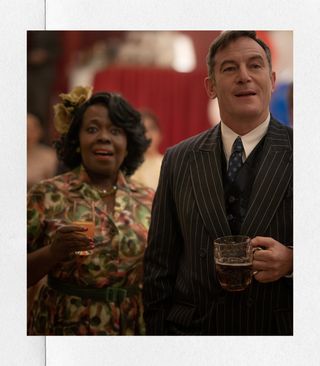
It’s amazing how fashion can have that kind of effect on people—even with Mrs. Harris and the Dior dress setting the whole story in motion. What about you? Was there a piece of clothing or costume that made you fall in love with this industry?
No, I’m not the least bit interested in fashion as fashion goes. The only thing I’ve ever really thought like, "Oh, that’s interesting” is [Yohji] Yamamoto did a dress that had straps, and you could do different things with them, and I thought that was quite clever actually. But it was way out of my price range. He is still probably one of the only people I look at. I love his men’s stuff. I think I would look great in it, but I actually think I would look like a badly wrapped parcel. I just wear work clothes and really couldn’t care less. But storytelling with clothes, now you are talking. Be it ’70s, ’50s, whatever. Not modern, though. Keep me away from modern. I just think it’s all too… I don’t know. I just can’t bear it actually. I just find it over-the-top, rich, luxe, serious. The ’50s are great. The ’70s are really good fun! I love a period [project].
What is your favorite look from the film and why?
Ugh! Do you know what I think it is? I think it’s with Rose [Williams]. It’s early on, and [her character Pamela Penrose] is saying, "What would I do without you, Mrs. Harris?” And of course, Mrs. Harris is doing up a hem that needs fixing. And she’s just with Pamela in that flat. There’s a photograph—I don’t know whether it’s in the film—where she’s kneeling behind her, and it’s just a lovely image of where they both are in their lives. And I think that’s probably my favorite.
Mrs. Harris Goes to Paris is in theaters July 15.
Jessica Baker is Who What Wear’s Executive Director, Entertainment, where she ideates, books, writes, and edits celebrity and entertainment features.
-
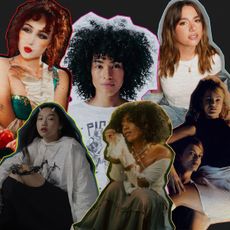 Our 2024 "Ones to Watch in Music" List Is Here!
Our 2024 "Ones to Watch in Music" List Is Here!Time to refresh your playlists.
By Jessica Baker
-
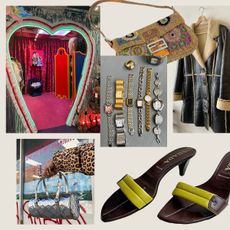 From Bella Hadid to Vogue Staffers—These Are the 10 Insider-Approved Vintage Stores in NYC
From Bella Hadid to Vogue Staffers—These Are the 10 Insider-Approved Vintage Stores in NYCNo gatekeeping here.
By Anna LaPlaca
-
 Zendaya's Going to Set Off Tomdaya Fans With This Red Carpet Wedding Dress
Zendaya's Going to Set Off Tomdaya Fans With This Red Carpet Wedding DressLaw Roach never misses.
By Eliza Huber
-
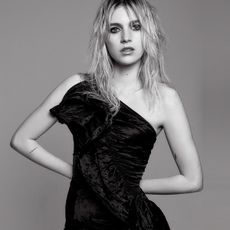 Nell Tiger Free Is This Generation's Scream Queen
Nell Tiger Free Is This Generation's Scream QueenFrom Servant to The First Omen, the actor has found her sweet spot in the horror genre.
By Jessica Baker
-
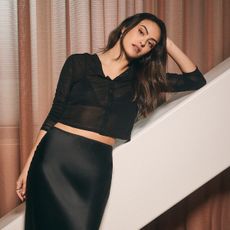 Camila Mendes Is Getting Back to Her Roots
Camila Mendes Is Getting Back to Her RootsStarting with her new film, Música.
By Jessica Baker
-
 Zendaya Wore a Plunging V-Neck Gown With a Thigh-High Slit on the Red Carpet
Zendaya Wore a Plunging V-Neck Gown With a Thigh-High Slit on the Red CarpetPerfect.
By Eliza Huber
-
 The Transformation of Sydney Sweeney
The Transformation of Sydney SweeneyYou've never seen the 26-year-old quite like this.
By Eliza Huber
-
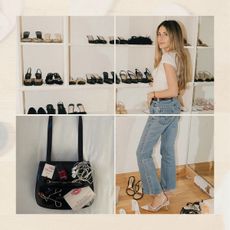 The Women Behind Instagram's Designer-Vintage Craze
The Women Behind Instagram's Designer-Vintage CrazeI suggest you get to know them.
By Eliza Huber

